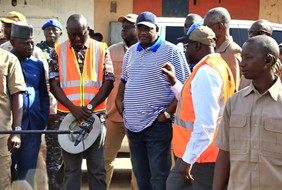BANJUL, THE GAMBIA – President Adama Barrow has announced the commencement of Phase Three of his administration’s massive national road infrastructure transformation project, promising to enhance connectivity, reduce flooding, and stimulate economic development across urban and rural parts of The Gambia.
Speaking during a presidential inspection tour of ongoing road construction projects in the Greater Banjul Area and West Coast Region, President Barrow reaffirmed his government’s commitment to delivering lasting infrastructure solutions to the people.
Joined by cabinet ministers, officials from the Ministry of Works, and the National Road Authority (NRA) led by Deputy Managing Director Sulayman Sumareh Janneh, the president visited several key sites where major roadworks are in progress.
One of the highlighted areas was Ebo Town, which has historically suffered from poor roads and recurring flooding. President Barrow, while interacting with enthusiastic residents who lined the streets to welcome him, vowed to reverse years of neglect.
“We aim not only to construct a road in Ebo Town but to build a standard road that will endure for years. This area is important to my administration,” he said. “We are also conducting studies to ensure flooding becomes a thing of the past.”
The Ebo Town road stretch, spanning approximately seven kilometers from Jeshwang to the riverside, is a centerpiece of the current development plan. Barrow emphasized that this is more than a cosmetic upgrade, stating that millions of dollars are being invested in road and drainage systems to resolve underground water issues permanently.
In addition to Ebo Town, the president inspected multiple road sections including:
Sinchu Wellingara to Kunkujang Keitaya (4.2 km)
Farato Bojang Kunda to Bafuloto (4 km)
Kololi Tavern to Brufut (8.6 km)
Sukuta Health Center to Senegambia Road (3.25 km)
Kololi Senegambia Intersection to Touba Sanchaba Road (1.14 km)
These roads form part of the Organisation of Islamic Cooperation (OIC)-funded urban roads network. According to the president, most of the OIC roads are near completion, except for the Nema Road, which remains under construction.
The inspection also took the delegation to Tabokoto–Abuko–Banjulinding Road (3.4 km) under EPC Lot 5, where local communities highlighted long-standing concerns about road deterioration during the rainy season. In response, President Barrow promised swift intervention, stating that his government is moving with urgency to connect remote areas to central trade routes such as the Brikama–Westfield Highway.
At the Farato Bojang Kunda site, he said the road would serve as a critical economic artery, linking farmers and small businesses to markets and services, thereby improving livelihoods and trade mobility.
“We have made substantial progress. Our regular inspections every month or two allow us to personally track implementation,” he told journalists. “The communities are seeing the change, and we are satisfied with the pace of work.”
Barrow also credited the National Road Authority and Ministry of Works for their supervision, praising development partners and donors for their contributions to key road segments, while stressing that government-funded projects are also progressing well.
“Beyond donor-funded roads, we are implementing about 365 km of roads directly under the central government, with three roads currently under construction. We are nearing completion of Phase Two, and Phase Three will begin before the end of the year,” Barrow said.
While road infrastructure remains the government’s top development priority, the president was quick to highlight other ongoing efforts, including school construction and electrification projects.
“Development can’t happen without roads, but it also can’t happen in isolation. We are committed to multi-sector development, and we’re delivering across the board,” he added.
Residents of areas like Ebo Town, once excluded from previous national development plans, say they are hopeful and grateful. One resident remarked: “We’ve waited decades to see this kind of work here. Now our children can walk safely to school, and traders can move their goods even in the rainy season.”
President Barrow’s infrastructure program, if delivered as promised, is expected to transform mobility, ease access to healthcare and education, and create jobs, setting the stage for long-term socio-economic upliftment.
As the country continues to rebuild and modernize, Barrow reiterated that his administration will keep the momentum alive and ensure every promise made is fulfilled.
